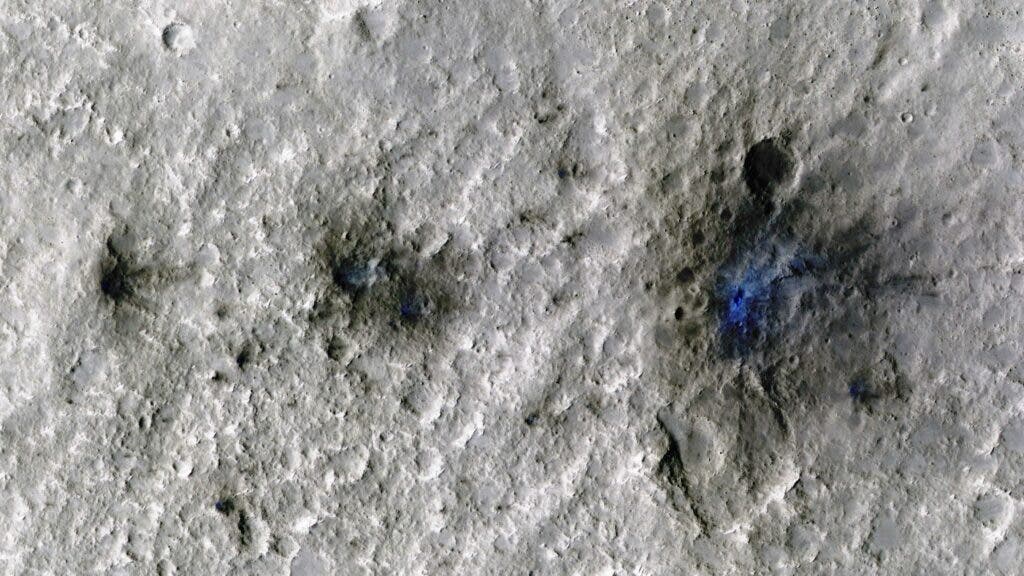Asteroid impacts make for breathtakingly violent events in TV shows and video games. But in real life, they can sometimes sound… a bit underwhelming.

For the last 4 years, NASA’s InSight craft has been busy at work keeping tabs on the internal workings of Mars. It does so through the use of a suite of fancy and sensitive equipment, including a seismometer, heat flow probe, radiometer, and “X-band radio”.
All that monitoring equipment allowed InSight to make an incredible recording last September: the sound of asteroid chunks hitting the surface of the planet. And it’s not what we expected to hear.
Going out with a ‘bloop’
The event created a surprisingly faint sound, considering its apparent violent nature. You can hear it in this recording that NASA made public on their Soundcloud account.
The noise we can hear here at around the 3-second-mark was carried by soundwaves traveling through the thin, dry atmosphere of the red planet. It was produced by an asteroid that exploded into multiple pieces upon entering the Martian atmosphere, pieces which then collided with its surface hard enough to leave behind a crater.
Soundwaves travel through the air at different velocities depending on the physical properties of that air. The impact on Mars occurred after sunset when the thin, dry air around Mars still retained a good part of the heat it accumulated during the day. Under such conditions, low-pitch sounds travel faster than high-pitched ones.
So if an observer had been closeby when the asteroid hit Mars, they would hear a loud ‘bang’, rich in high-pitched sound waves. But InSight was a considerable way away from the site, so it picked up on the low (bass) frequencies of the sound before it did the high-pitch ones — so what it heard was more of a ‘bloop’, NASA explains.
Although InSight was designed to pick up on ‘marsquakes’, it was also well-suited to capturing the sound of the impact. Earthquakes propagate through mechanical waves that are essentially identical to sound waves. The current recording showcases that InSight can also be used to an extent to keep track of what’s happening not only under the crust of Mars, but also on and slightly above it. The sound of the asteroid exploding and its pieces hitting the ground produced just enough motion in the ground for InSight to be able to pick them up.
Researchers were aware that the craft could pick up on such events and have been on the lookout for them, but this impact on September 5th 2021 was the first time we’ve actually seen one recorded by InSight’s Seismic Experiment for Interior Structure (SEIS) instrument.
Based on the SEIS data, they were then able to triangulate the location of the impact. The Mars Orbiter was sent on a flyby over the site in question to check things out, finding three craters.
“After three years of InSight waiting to detect an impact, those craters looked beautiful,” said Ingrid Daubar of Brown University in a NASA press release.
Using the knowledge produced by this event, NASA researchers were able to go back through previous datasets provided by InSight and look for events that matched the signature of this asteroid impact. They discovered three more likely impacts peppered throughout the over 1,300 marsquakes that were previously recorded by SEIS.
“Our findings demonstrate the capability of planetary seismology to identify impact-generated seismic sources and constrain both impact processes and planetary interiors,” explains a paper detailing the analysis, co-authored by Daubar.
This discovery represents a nice moment for InSight, which has been serving faithfully on the surface of Mars. But it’s also a little saddening as it reminds us of the instrument’s value at a time when it isn’t doing very great. InSight’s solar panels have continuously gathered dust over the last 4 years to the extent that it is having difficulties powering itself. As things stand now, it is expected to shut down later this year.
The paper “Newly formed craters on Mars located using seismic and acoustic wave data from InSight” has been published in the journal Nature Geoscience.









